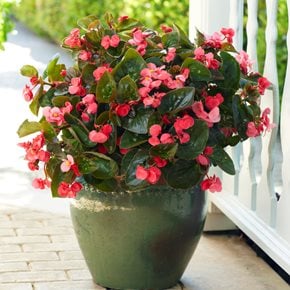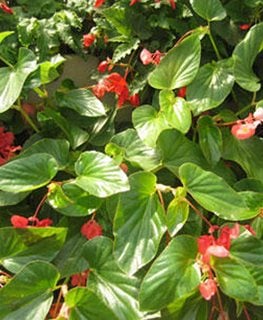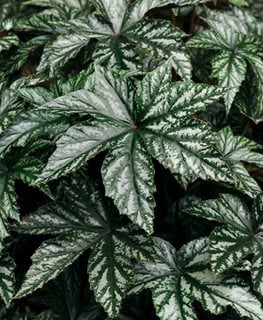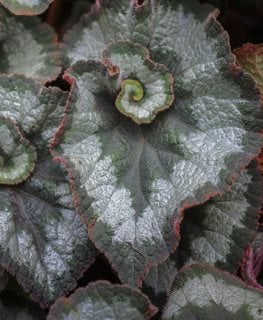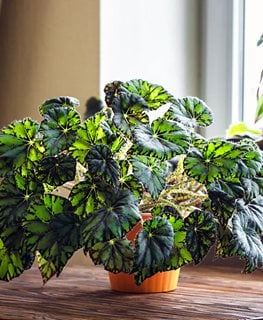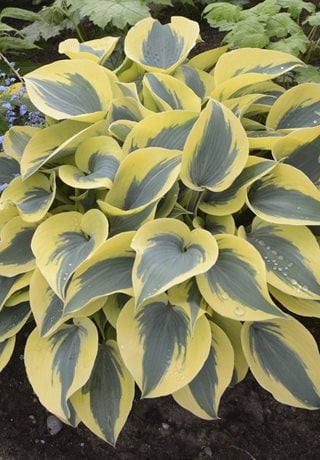How to Grow & Care for Beautiful Begonias
Planting, growing and caring for these shade garden superstars Updated 4/4/2025Typically used in shaded summer beds and houseplants, begonias have tropical and subtropical origins and are often found growing as forest understory plants in their native habitats. Some varieties are grown for their asymmetrical, patterned, or variegated foliage, while others add vibrant color to shady garden areas with their bright blooms. Although typically on the smaller side, begonia plants pack a big punch of color and interest, making them a favorite for both indoor containers and outdoor beds.
"We love begonias—so many beautiful colors and bloom types. They’re perfect for containers, especially in part-shade or shady spots where you want a big pop of color.” — Sean & Allison, Spoken Garden
On this page: Basics | Types | Planting | Care | Begonia Varieties | Design Ideas | Growing as Houseplants | FAQs
On this page:
- BASICS
- COMMON BEGONIA TYPES
- PLANTING
- BEGONIA CARE
- BEGONIA VARIETIES
- IDEAS FOR USING IN THE GARDEN
- GROWING BEGONIAS AS HOUSEPLANTS
- FREQUENTLY ASKED QUESTIONS
BASICS
Zones:
Most varieties 9-11, but commonly grown as an annual or houseplant.
Height/Spread:
Varieties differ, from 6- to 12-inch houseplants to bushy plants 5 feet tall or more.
Exposure:
Sun to shade, depending on variety.
Bloom Time:
Varies, with the most common types, wax and tuberous begonias, blooming from early summer until frost. Bloom times may also vary if grown indoors and some types bloom all year.
COMMON TYPES OF BEGONIAS
Here are the most common types found in gardens and homes:
Fibrous begonias (wax begonias, bedding begonias):
These compact, shade-loving plants are often used as bedding annuals or in containers. They feature succulent stems, rounded green or bronze-tinted leaves, and 1- to 1½-inch blooms in red, pink, or white. Wax begonias typically grow 6 to 12 inches tall and wide, thriving in window boxes, hanging baskets, or beneath trees. Learn more about wax begonias.
Tuberous begonias (Rieger begonias):
Known for their bold, colorful flowers and trailing or upright habits, tuberous begonias bloom in shades of pink, orange, red, yellow, and white. They perform especially well in hanging baskets or containers. Outdoors, they may reach up to 3 feet tall; indoors, usually 12 to 18 inches. These begonias are frost-tender and require overwintering. Learn more about tuberous begonias.
Cane begonias (including angel wing begonias):
Cane begonias grow upright with bamboo-like stems and often produce clusters of dangling flowers. Their foliage is a highlight, especially in Angel Wing varieties, which have long, speckled leaves with reddish undersides. Sizes range from small houseplants to 5-foot-tall specimens in ideal conditions.
Rhizomatous begonias:
This is the largest and most diverse group, grown mainly for their foliage. These begonias spread via thick horizontal rhizomes and often have unusual, textured leaves. Sizes vary widely—from compact tabletop plants to large 3-foot varieties.
Rex begonias:
A popular subgroup of rhizomatous begonias, Rex types are prized for their dazzling foliage in shades of silver, burgundy, purple, and green. Though finicky about water and humidity, they make striking houseplants or seasonal accents in shady outdoor displays. Most grow 12 to 18 inches tall and wide.
"Begonias are a diverse group of plants, with more than 2,000 known species and thousands of cultivars. They grow in a wide range of environments, from tropical rainforests to high-altitude mountains.” — American Begonia Society
Learn more about the different types of begonias.
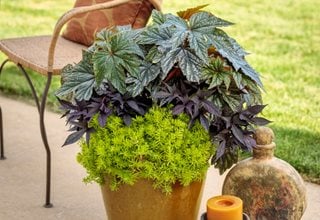
Mixed container. Pegasus® Begonia hybrid, Sweet Caroline Raven sweet potato vine, Proven Accents® Lemon Coral® sedum. Photo by Proven Winners.
PLANTING BEGONIAS
When to plant:
Transplant after all threat of frost has passed, as they are extremely frost tender and even temperatures below 50 degrees can cause damage.
Where to plant:
Select a location that gets partial shade or filtered sunlight; with morning sun and afternoon shade being the best, especially where it is exceptionally hot. For sunnier locations, try a dark-leaved variety or one that specifies improved sun tolerance, like Surefire® Rose. Plant in a location where they will have good air circulation to prevent powdery mildew.
How to plant:
Plant wax begonia transplants 6 to 8 inches apart and others according to their mature size. Tubers can be started indoors by placing the tubers, hollow side up, 1 inch apart in a shallow tray with moist potting mix. Place the tray in a dark room and water just enough to keep the potting mix moist, but not soggy. Tubers should sprout in about 4 weeks and be moved to an area with bright light once the sprouts are about an inch tall. Only plant outdoors when there is no longer a threat of frost.
BEGONIA CARE
Wax and rhizomatous begonias don’t go dormant. Lightly prune them in spring (warm climates) or fall (cooler zones) to maintain compact growth. Before bringing them indoors for winter, check for pests or disease. Gradually acclimate them to indoor conditions by starting in a bright window and slowly reducing light to avoid leaf drop. In spring, reverse the process and move them back outside.
Tuberous begonias die back naturally each year. Begin reducing water in late summer, and trim yellowing foliage in early fall. At the first frost threat, dig up the tubers, gently clean off soil, and let them dry on newspaper in a sunny spot for about a week. To prevent powdery mildew, dust with sulfur powder and store individually in paper bags or wrapped in newspaper.
How to prune begonias:
- Wax and Rhizomatous begonias: Make clean, angled cuts just above a leaf or flower node. Younger plants (under 3 years) can be cut back to 1–2 nodes above the soil to encourage fuller growth. Older plants should only be lightly pruned.
- Cane Begonias: Pinch the tops when plants reach 6 inches to promote branching. Remove tall or dead canes down to the soil. You can also cut back younger plants by about half, just above a node.
- Rex Begonias: These need minimal pruning. Pinch back to shape and remove leggy or bare stems as needed.
- All Types: Deadhead spent flowers about ½ inch below the bloom to encourage more blossoms and keep plants tidy.
Soil:
All begonias like evenly moist, well-draining soil with some added organic matter. For container-grown begonias, use a well-draining potting soil with added organic matter to help retain moisture without becoming soggy.
Amendments and fertilizer:
For general growing purposes, apply a balanced water-soluble fertilizer once a month in the growing season. For plants grown strictly for their foliage, like angel wings, use a fertilizer that is higher in nitrogen.
Watering:
Regular watering is important for healthy plants. The soil should remain moist at all times, but not too wet, as this can cause root rot. Water at the base of the plant to keep the foliage dry and prevent leaf spot and fungal diseases.
Winter care:
Begonias can be brought inside for overwintering. Put them in a window with bright filtered light and increase the humidity.
Diseases and pests:
Susceptible to powdery mildew, mealybugs, spider mites, thrips, and whitefly. Stem rot and rhizome rot can be caused by overwatering and soggy soil.
BEGONIA VARIETIES
DESIGN IDEAS FOR BEGONIAS:
- Wax begonias are one of the most popular bedding plants, often used to create colorful borders or fill gaps under trees where other plants may struggle.
- Trailing and mounding varieties look great in pots, window boxes and hanging baskets.
- Use upright varieties with unique foliage for a container centerpiece.
- Mix-n-match plants with contrasting leaf colors, shapes and textures for a unique container combination.
- Select darker-leaved varieties or types with improved heat and sun tolerance for sunnier spots.
- Search container combinations that include begonias.
GROWING BEGONIAS AS HOUSEPLANTS
Many begonias make excellent houseplants with the right care. Avoid overwatering-let the soil dry slightly between waterings-and boost humidity with a pebble tray. Place near a bright east- or west-facing window, or use grow lights if natural light is limited. Begonias prefer to be slightly root-bound, so only repot when necessary, ideally in spring.
Explore our indoor begonia care guide—light, water, and more made simple.
FREQUENTLY ASKED QUESTIONS:
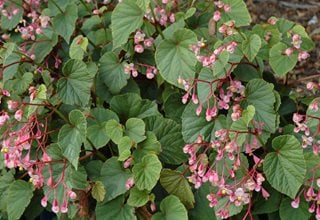
Cold hardy tuberous begonia (Begonia grandis var. evansiana)
Photo by: Tim Ludwig / Millette Photomedia
Are begonias poisonous?
Begonias are toxic to pets, with the tubers being the most poisonous part. They are not toxic to humans, although may cause allergic reactions. See more Common Poisonous Plants for Dogs and Cats.
Are begonias deer resistant?
Begonias are deer resistant.
Do begonias like sun or shade?
Begonias do best in partial shade or a spot that receives morning sun and afternoon shade, but there are also varieties that can tolerate full sun.
Do begonias come back every year?
Only in warm climates. Begonias are tender perennials in Zones 9–11 but are usually grown as annuals elsewhere. Tuberous types can come back if you dig up and store the tubers over winter. Wax and cane types can be overwintered indoors as houseplants.
Do begonias do better in pots or in the ground?
Begonias thrive in both pots and the ground, depending on the variety and your growing conditions. Potted begonias are ideal for control over soil, moisture, and light, while in-ground planting works well in shady, well-drained garden beds. Tuberous and Rex types often prefer containers, while wax and fibrous types do well in beds or borders.
Are there any cold-hardy begonias?
Begonia grandis varieties are cold-hardy plants suitable for Zones 6 to 9. They grow 12 to 18 inches tall and wide and thrive in part shade to full shade locations. They’ll bloom from early summer until frost with clusters of slightly fragrant, light pink flowers, and they have large heart-shaped medium green leaves. Plants will die back completely in the fall and reappear in late spring the following year.
What are strawberry begonias?
Saxifraga stolonifera, often called strawberry begonia, has a similar leaf structure — fuzzy, with green and silver variegation and hints of red — but isn’t a true begonia. It spreads like a strawberry plant by sending out runners, or stolons.
RELATED:
20 Best Summer Bulbs to Grow
